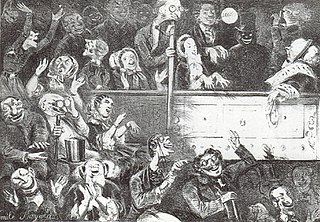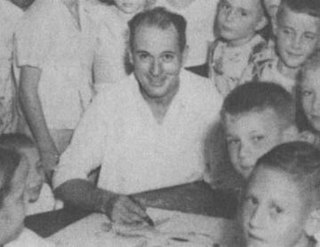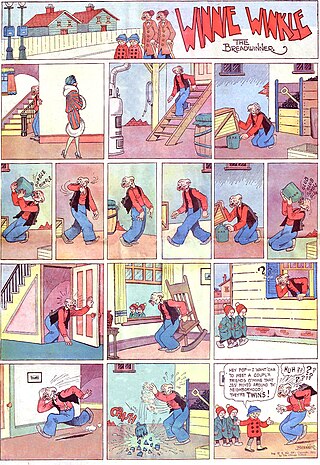
A comic strip is a sequence of cartoons, arranged in interrelated panels to display brief humor or form a narrative, often serialized, with text in balloons and captions. Traditionally, throughout the 20th and into the 21st century, these have been published in newspapers and magazines, with daily horizontal strips printed in black-and-white in newspapers, while Sunday papers offered longer sequences in special color comics sections. With the advent of the internet, online comic strips began to appear as webcomics.

A cartoon is a type of visual art that is typically drawn, frequently animated, in an unrealistic or semi-realistic style. The specific meaning has evolved, but the modern usage usually refers to either: an image or series of images intended for satire, caricature, or humor; or a motion picture that relies on a sequence of illustrations for its animation. Someone who creates cartoons in the first sense is called a cartoonist, and in the second sense they are usually called an animator.

Doonesbury is a comic strip by American cartoonist Garry Trudeau that chronicles the adventures and lives of an array of characters of various ages, professions, and backgrounds, from the President of the United States to the title character, Michael Doonesbury, who has progressed over the decades from a college student to a youthful senior citizen.

Operetta is a form of theatre and a genre of light opera. It includes spoken dialogue, songs, and dances. It is lighter than opera in terms of its music, orchestral size, and length of the work. Apart from its shorter length, the operetta is usually of a light and amusing character. The subject matter may portray "lovers' spats, mistaken identities, sudden reversals of fortune, and glittering parties". It sometimes also includes satirical commentaries.

Charles Alfred "Al" Taliaferro, was an American Disney comics artist who produced Disney comic strips for King Features Syndicate. Taliaferro is best known for his work on the Donald Duck comic strip. Many of his strips were written by Bob Karp.

The Phantom is an American adventure comic strip, first published by Lee Falk in February 1936. The main character, the Phantom, is a fictional costumed crime-fighter who operates from the fictional African country of Bangalla. The character has been adapted for television, film and video games.
Tom the Dancing Bug is a weekly satirical comic strip by cartoonist and political commentator Ruben Bolling that covers mostly US current events from a liberal point of view. Tom the Dancing Bug won the 2002, 2003, 2007, 2008, and 2009 Association of Alternative Newsweeklies Awards for Best Cartoon. The strip was awarded the 2010 Sigma Delta Chi Award for editorial cartooning by the Society of Professional Journalists and best cartoon in the 2018 Robert F. Kennedy Book & Journalism Awards. His work on the strip won Bolling the 2017 Herblock Prize and the 2021 Berryman Award for Editorial Cartoons, and he was a finalist in the Editorial Cartooning category for the 2019 and 2021 Pulitzer Prize.

Austrian culture is characterised by historical and modern influences, including a history of interaction primarily between Celtic, Roman, Slavic and Germanic peoples. Austria is particularly known for its classical music, folk music, baroque architecture, coffee culture, winter sports and Alpine traditions.

Arlo and Janis is an American gag-a-day comic strip written and drawn by Jimmy Johnson. It is a leisurely paced domestic situation comedy. It was first published in newspapers on July 29, 1985.
German comics are comics written in the German language or by German-speaking creators, for the major comic markets in Germany, Austria, and Switzerland, with spill-overs into the neighboring, but lesser, comic markets of Liechtenstein, Luxembourg and German-speaking Belgium.

Chesty Bond is a fictional cartoon character and trademark for the Australian clothing company Bonds. The character was created in 1940, a co-creation of the advertising account manager Ted Moloney and artist Syd Miller. Chesty Bond was conceived as a likeable and heroic character in a continuous newspaper comic-strip, intended as a marketing campaign to sell the Bonds Athletic singlet. The comic-strip format, with a constantly changing storyline, proved to be extremely popular and continued to be published until 1963. Chesty Bond was possibly the world’s first daily advertising comic-strip. By virtue of its popularity and longevity, Chesty Bond became absorbed into Australian popular culture as a national icon.

Superman was a daily newspaper comic strip which began on January 16, 1939, and a separate Sunday strip was added on November 5, 1939. These strips ran continuously until May 1966. In 1941, the McClure Syndicate had placed the strip in hundreds of newspapers. At its peak, the strip, featuring Superman, was in over 300 daily newspapers and 90 Sunday papers, with a readership of over 20 million. A spin-off, Lois Lane, Girl Reporter, ran irregularly between 1943 and 1944.

Winnie Winkle is an American comic strip published during a 76-year span (1920–1996). Ten film adaptations were also made. Its premise was conceived by Joseph Medill Patterson, but the stories and artwork were by Martin Branner, who wrote the strip for over 40 years. It was one of the first comic strips about working women. The main character was a young woman who had to support her parents and adopted brother, serving as a reflection of the changing role of women in society. It ran in more than 100 newspapers and translations of the strip's Sunday pages were made available in Europe, focusing on her little brother Perry Winkle and his gang.

The men's dormitory on Meldemannstraße 27 in Brigittenau district, Vienna, Austria was a public dormitory for men (Männerwohnheim) from 1905 to 2003. It is a subject of public interest primarily because from 1910 to 1913, it was the residence of Adolf Hitler, who later became dictator of Nazi Germany.

Carl Frank Ludwig Ed was a comic strip artist best known as the creator of Harold Teen. His name is pronounced eed.
Tobias Seicherl is the title character of a comic drawn by Viennese caricaturist Ladislaus Kmoch, a self-taught cartoonist. The comic appeared as a daily strip in the Austrian tabloid Das Kleine Blatt published by Vorwärts-Verlag from October 5, 1930. Tobias Seicherl can be regarded as the first continental European daily comic strip.

Canadian comics refers to comics and cartooning by citizens of Canada or permanent residents of Canada regardless of residence. Canada has two official languages, and distinct comics cultures have developed in English and French Canada. The English tends to follow American trends, and the French, Franco-Belgian ones, with little crossover between the two cultures. Canadian comics run the gamut of comics forms, including editorial cartooning, comic strips, comic books, graphic novels, and webcomics, and are published in newspapers, magazines, books, and online. They have received attention in international comics communities and have received support from the federal and provincial governments, including grants from the Canada Council for the Arts. There are comics publishers throughout the country, as well as large small press, self-publishing, and minicomics communities.
Notable events of 1930 in comics.
Donald Duck is an American comic strip by the Walt Disney Company starring Donald Duck, distributed by King Features Syndicate. The first daily Donald Duck strip debuted in American newspapers on February 7, 1938. On December 10, 1939, the strip expanded to a Sunday page as well. Writer Bob Karp and artist Al Taliaferro worked together on the strip for more than 30 years. The strip ended in May 1995.
Das Kleine Blatt was an Austrian newspaper which was published in Vienna. The paper was affiliated with the Social Democratic Workers' Party, known as the Social Democratic Party. It was started in 1927 and published until 1971 with some interruptions.












